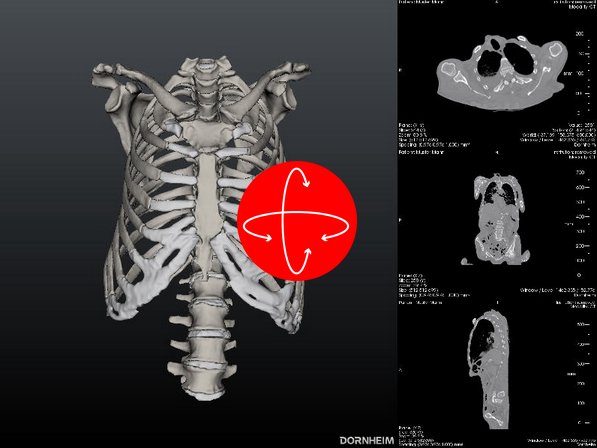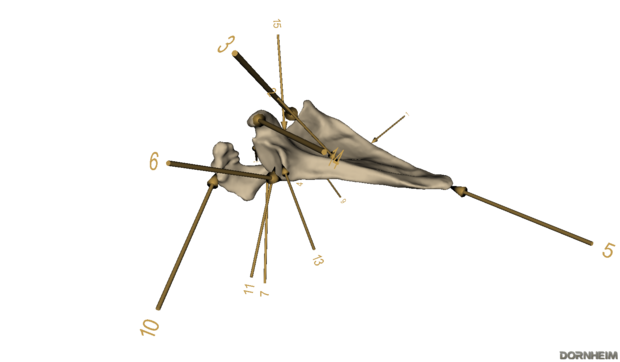Schulterblatt/en: Unterschied zwischen den Versionen
Becher (Diskussion | Beiträge) |
(Übernehme Bearbeitung einer neuen Version der Quellseite) |
||
| Zeile 1: | Zeile 1: | ||
<languages/> | <languages/> | ||
| − | == | + | ==Übersicht== |
| − | + | Das Schulterblatt (lat. Scapula) bildet zusammen mit der [[Special:MyLanguage/Schlüsselbein|Clavicula]] den knöchernen [[Special:MyLanguage/Schultergürtel|Schultergürtel]]. Die Scapula stellt einen flachen dreiseitigen Knochen dar. Er befindet sich am dorsalen Brustkorb und ist koplett in Muskelschlingen eingelagert. Er besitzt eine Verbindung zum [[Special:MyLanguage/Oberarmknochen|Oberarmknochen]] und zum Schlüsselbein. | |
| − | |||
| − | |||
| − | |||
| + | ==Anatomie== | ||
<!--[segmenter_embed b7GTgSO6dYaQ name=schulter float=right timeout=60 margin=20]--> | <!--[segmenter_embed b7GTgSO6dYaQ name=schulter float=right timeout=60 margin=20]--> | ||
| − | [[File:ViewerScapula.png|right| | + | [[File:ViewerScapula.png|right|Scapula im Viewer betrachten]] |
| − | <!--[segmenter_snapshot schulter 7]-->[[File:Scapula.png|620px|right|Scapula | + | <!--[segmenter_snapshot schulter 7]-->[[File:Scapula.png|620px|right|Scapula mit Beschriftungen]]<!--[/]--> |
| − | |||
| − | |||
| − | |||
| − | |||
| − | |||
| − | |||
| − | |||
| − | |||
| − | |||
| − | |||
| − | |||
| + | Die Scapula ist ein dreiseitiger, platter Knochen. Sie stellt zusammen mit der Clavicula den Schultergürtel dar. Sie besitzt eine Vielzahl an knöchernen Strukturen. Das Schulterblatt befindet sich dorsal am Thorax und ist komplett in Muskeln eingelagert. Diese Muskulatur bildet die Verbindung zum [[Special:MyLanguageRumpf. Am Schulterblatt wird das Schultergelenk an der Verbindungsstelle zum Humerus gebildet. Über das Akromionklavikulargelenk artikulieren Schulterblatt und Schlüsselbein miteinander. | ||
| + | |||
----- | ----- | ||
| − | '' | + | ''weiterführende Links'' |
| − | [[Special:MyLanguage/Übungsaufgaben| | + | [[Special:MyLanguage/Übungsaufgaben|Übungsaufgaben]] |
| − | [[Special:MyLanguage/Obere Extremität| | + | [[Special:MyLanguage/Obere Extremität|zurück]] |
Version vom 5. Februar 2020, 13:55 Uhr
Übersicht
Das Schulterblatt (lat. Scapula) bildet zusammen mit der Clavicula den knöchernen Schultergürtel. Die Scapula stellt einen flachen dreiseitigen Knochen dar. Er befindet sich am dorsalen Brustkorb und ist koplett in Muskelschlingen eingelagert. Er besitzt eine Verbindung zum Oberarmknochen und zum Schlüsselbein.
Anatomie
Die Scapula ist ein dreiseitiger, platter Knochen. Sie stellt zusammen mit der Clavicula den Schultergürtel dar. Sie besitzt eine Vielzahl an knöchernen Strukturen. Das Schulterblatt befindet sich dorsal am Thorax und ist komplett in Muskeln eingelagert. Diese Muskulatur bildet die Verbindung zum [[Special:MyLanguageRumpf. Am Schulterblatt wird das Schultergelenk an der Verbindungsstelle zum Humerus gebildet. Über das Akromionklavikulargelenk artikulieren Schulterblatt und Schlüsselbein miteinander.
weiterführende Links

